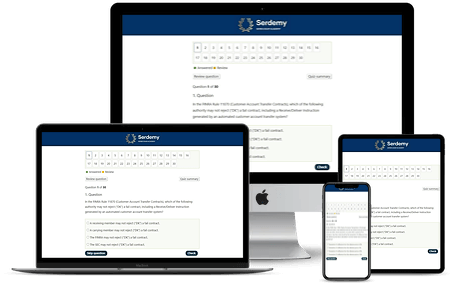Quiz-summary
0 of 30 questions completed
Questions:
- 1
- 2
- 3
- 4
- 5
- 6
- 7
- 8
- 9
- 10
- 11
- 12
- 13
- 14
- 15
- 16
- 17
- 18
- 19
- 20
- 21
- 22
- 23
- 24
- 25
- 26
- 27
- 28
- 29
- 30
Information
Premium Practice Questions
You have already completed the quiz before. Hence you can not start it again.
Quiz is loading...
You must sign in or sign up to start the quiz.
You have to finish following quiz, to start this quiz:
Results
0 of 30 questions answered correctly
Your time:
Time has elapsed
Categories
- Not categorized 0%
- 1
- 2
- 3
- 4
- 5
- 6
- 7
- 8
- 9
- 10
- 11
- 12
- 13
- 14
- 15
- 16
- 17
- 18
- 19
- 20
- 21
- 22
- 23
- 24
- 25
- 26
- 27
- 28
- 29
- 30
- Answered
- Review
-
Question 1 of 30
1. Question
Anya, a General Securities Sales Supervisor holding both Series 9 and 10 registrations, is conducting a pre-use review of a draft social media post from Leo, a registered representative. The draft, intended for the firm’s approved platform, reads: “Tired of a flat market? A short straddle on GHI stock could be your answer for income generation. This strategy profits from low volatility, and our firm’s analysis suggests GHI will be range-bound for weeks. Contact me to see if this fits your portfolio!” As the supervising principal, what is the most critical regulatory failure Anya must address before considering approval?
Correct
The proposed communication is in violation of FINRA rules because it is not fair and balanced due to the omission of the significant risks associated with the strategy. FINRA Rule 2210, Communications with the Public, requires that all member firm communications be based on principles of fair dealing and good faith, be fair and balanced, and provide a sound basis for evaluating the facts in regard to any particular security or service. A key component of the fair and balanced standard is that communications must not omit material facts or qualifications if the omission, in context, would cause the communication to be misleading. Furthermore, communications must not make any false, exaggerated, unwarranted, promissory, or misleading statement or claim. FINRA Rule 2220, which specifically governs options communications, reinforces these principles. It explicitly states that any statement referring to the potential advantages or opportunities of options must be balanced by a statement of the corresponding risks. The short straddle strategy, which involves selling both a call and a put option with the same strike price and expiration date, has a risk profile of unlimited potential loss. By promoting the income-generating potential of the strategy in a low-volatility environment without clearly and prominently disclosing the unlimited risk, the communication is fundamentally misleading and unbalanced. A principal must ensure that any discussion of options strategies, especially high-risk ones, includes a clear description of the associated risks to comply with supervisory obligations.
Incorrect
The proposed communication is in violation of FINRA rules because it is not fair and balanced due to the omission of the significant risks associated with the strategy. FINRA Rule 2210, Communications with the Public, requires that all member firm communications be based on principles of fair dealing and good faith, be fair and balanced, and provide a sound basis for evaluating the facts in regard to any particular security or service. A key component of the fair and balanced standard is that communications must not omit material facts or qualifications if the omission, in context, would cause the communication to be misleading. Furthermore, communications must not make any false, exaggerated, unwarranted, promissory, or misleading statement or claim. FINRA Rule 2220, which specifically governs options communications, reinforces these principles. It explicitly states that any statement referring to the potential advantages or opportunities of options must be balanced by a statement of the corresponding risks. The short straddle strategy, which involves selling both a call and a put option with the same strike price and expiration date, has a risk profile of unlimited potential loss. By promoting the income-generating potential of the strategy in a low-volatility environment without clearly and prominently disclosing the unlimited risk, the communication is fundamentally misleading and unbalanced. A principal must ensure that any discussion of options strategies, especially high-risk ones, includes a clear description of the associated risks to comply with supervisory obligations.
-
Question 2 of 30
2. Question
Ananya, a General Securities Sales Supervisor holding Series 9 and 10 registrations, is reviewing a draft seminar handout prepared by Leo, a registered representative. The handout describes a covered call writing strategy on stock XYZ and includes a worksheet detailing a hypothetical trade that was successful over the previous three months. The worksheet concludes by stating, “This strategy generated a 6% return in three months, which represents a potential annualized return of 24%.” To comply with FINRA and Cboe rules governing options communications, what is the most critical action Ananya must instruct Leo to take?
Correct
The core issue is the projection of an annualized rate of return in a retail communication about options. FINRA Rule 2220, which governs options communications, strictly prohibits projecting rates of return. While it is permissible to show historical performance, it cannot be presented in a way that implies a future rate of return, and it must be balanced. Specifically, projecting an annualized return based on a short, successful period is considered misleading and is a violation. The communication must also include numerous disclosures, such as the fact that past performance does not guarantee future results, that commissions and other charges are not included in the calculation, and that the communication must be preceded or accompanied by the current Options Disclosure Document (ODD). The supervisor’s primary responsibility under Rule 2220 and Cboe Rule 9.15 is to ensure that such misleading projections are removed entirely. Simply adding a disclaimer is insufficient to cure the violation of projecting a rate of return. The communication must be fair, balanced, and not misleading. Therefore, the supervisor must direct the representative to remove the annualized projection and ensure all other required disclosures and conditions are met before a Registered Options Principal (ROP) can approve it for use.
Incorrect
The core issue is the projection of an annualized rate of return in a retail communication about options. FINRA Rule 2220, which governs options communications, strictly prohibits projecting rates of return. While it is permissible to show historical performance, it cannot be presented in a way that implies a future rate of return, and it must be balanced. Specifically, projecting an annualized return based on a short, successful period is considered misleading and is a violation. The communication must also include numerous disclosures, such as the fact that past performance does not guarantee future results, that commissions and other charges are not included in the calculation, and that the communication must be preceded or accompanied by the current Options Disclosure Document (ODD). The supervisor’s primary responsibility under Rule 2220 and Cboe Rule 9.15 is to ensure that such misleading projections are removed entirely. Simply adding a disclaimer is insufficient to cure the violation of projecting a rate of return. The communication must be fair, balanced, and not misleading. Therefore, the supervisor must direct the representative to remove the annualized projection and ensure all other required disclosures and conditions are met before a Registered Options Principal (ROP) can approve it for use.
-
Question 3 of 30
3. Question
As the General Securities Sales Supervisor at a branch office, you are reviewing a draft PowerPoint presentation prepared by a registered representative, Kenji, for an upcoming public seminar titled “Unlocking Wealth with Equity Options.” One slide prominently features a hypothetical example of a covered call strategy on a volatile tech stock, concluding with the statement: “This simple strategy can generate projected annual returns of over 25% with minimal effort.” The slide briefly mentions risk in a small footnote. In your assessment of this communication under FINRA rules, what is the most significant and immediate supervisory concern that must be addressed?
Correct
Not applicable as this is a conceptual question. Under FINRA Rule 2210, all communications with the public must be fair, balanced, and not misleading. Specifically for options communications, FINRA Rule 2220 imposes even stricter standards. Any retail communication that presents projected performance of options strategies must be pre-filed with FINRA’s Advertising Regulation Department at least ten business days prior to its first use. Crucially, such projections must be accompanied by a detailed explanation of the basis and assumptions used in the calculation. Simply stating a potential high rate of return without this basis, and without giving equal prominence to the significant risks involved, constitutes a serious violation. The communication fails to provide the necessary context for an investor to understand how the projection was derived and the substantial potential for loss. A supervisor’s primary responsibility is to ensure that communications do not contain exaggerated or unwarranted claims. The lack of a reasonable basis for the projection and the failure to adequately balance this with risk disclosures are fundamental flaws that must be addressed before any other procedural steps, like principal approval or filing, can be properly completed. The supervisor must halt the use of this material and require a complete rewrite to include a sound basis for any performance figures and prominent, clear risk disclosures.
Incorrect
Not applicable as this is a conceptual question. Under FINRA Rule 2210, all communications with the public must be fair, balanced, and not misleading. Specifically for options communications, FINRA Rule 2220 imposes even stricter standards. Any retail communication that presents projected performance of options strategies must be pre-filed with FINRA’s Advertising Regulation Department at least ten business days prior to its first use. Crucially, such projections must be accompanied by a detailed explanation of the basis and assumptions used in the calculation. Simply stating a potential high rate of return without this basis, and without giving equal prominence to the significant risks involved, constitutes a serious violation. The communication fails to provide the necessary context for an investor to understand how the projection was derived and the substantial potential for loss. A supervisor’s primary responsibility is to ensure that communications do not contain exaggerated or unwarranted claims. The lack of a reasonable basis for the projection and the failure to adequately balance this with risk disclosures are fundamental flaws that must be addressed before any other procedural steps, like principal approval or filing, can be properly completed. The supervisor must halt the use of this material and require a complete rewrite to include a sound basis for any performance figures and prominent, clear risk disclosures.
-
Question 4 of 30
4. Question
Anya, a General Securities Sales Supervisor, is conducting a routine review of her team’s electronic correspondence. She flags an email from Leo, a registered representative, to his client, Mei. The email details Leo’s personal financial struggles and requests a $15,000 loan from Mei. Leo promises to repay the loan with interest derived from what he describes as a ‘guaranteed’ return on a private placement he is purchasing in his personal brokerage account, which he mentions is held at a competing firm. Based on Anya’s review of Leo’s employment file, there is no record of an outside brokerage account or any lending arrangement. Which of the following represents the most accurate and complete assessment of the FINRA rule violations Anya has uncovered?
Correct
The situation described involves multiple, distinct violations of FINRA rules that a supervisor must identify. First, the registered representative, Leo, is attempting to borrow money from a client, Mei. FINRA Rule 3240 strictly governs borrowing from and lending to customers. Such arrangements are prohibited unless they fall under specific exceptions, such as the customer being an immediate family member or a financial institution in the business of lending, and even then, the firm’s written supervisory procedures must permit it and, in most cases, the firm must provide written pre-approval. The scenario does not suggest any of these conditions are met. Second, Leo mentions conducting a transaction in a personal brokerage account held at a competing firm. FINRA Rule 3210 requires associated persons to obtain prior written consent from their employing member before opening or maintaining a securities account at another member firm. The lack of this disclosure in his file is a direct violation. Third, Leo’s email contains a promise of a ‘guaranteed’ return on a private placement. This constitutes a misleading and promissory statement, which is a violation of FINRA Rule 2210 on Communications with the Public. This rule requires all communications to be fair, balanced, and not contain any false, exaggerated, unwarranted, or misleading statements or claims. Guaranteeing investment returns is a serious breach of this standard. A supervisor must recognize all these separate issues stemming from a single piece of correspondence.
Incorrect
The situation described involves multiple, distinct violations of FINRA rules that a supervisor must identify. First, the registered representative, Leo, is attempting to borrow money from a client, Mei. FINRA Rule 3240 strictly governs borrowing from and lending to customers. Such arrangements are prohibited unless they fall under specific exceptions, such as the customer being an immediate family member or a financial institution in the business of lending, and even then, the firm’s written supervisory procedures must permit it and, in most cases, the firm must provide written pre-approval. The scenario does not suggest any of these conditions are met. Second, Leo mentions conducting a transaction in a personal brokerage account held at a competing firm. FINRA Rule 3210 requires associated persons to obtain prior written consent from their employing member before opening or maintaining a securities account at another member firm. The lack of this disclosure in his file is a direct violation. Third, Leo’s email contains a promise of a ‘guaranteed’ return on a private placement. This constitutes a misleading and promissory statement, which is a violation of FINRA Rule 2210 on Communications with the Public. This rule requires all communications to be fair, balanced, and not contain any false, exaggerated, unwarranted, or misleading statements or claims. Guaranteeing investment returns is a serious breach of this standard. A supervisor must recognize all these separate issues stemming from a single piece of correspondence.
-
Question 5 of 30
5. Question
Consider a scenario where a client, Kenji, has a new margin account with no initial funding. On Monday (trade date T), he executes a purchase of 1,000 shares of a marginable security, LMN Corp., at a price of $50 per share. A Regulation T call is subsequently issued. By the close of business on Friday (T+4), Kenji has not deposited any funds to meet the call. As the General Securities Sales Supervisor responsible for this account, you must ensure proper procedure is followed on the morning of the next business day (T+5). What is the minimum market value of securities that must be liquidated from Kenji’s account to satisfy the firm’s regulatory obligation?
Correct
The initial transaction is the purchase of 1,000 shares of LMN Corp. at $50 per share. The total market value of the purchase is calculated as: \[1,000 \text{ shares} \times \$50/\text{share} = \$50,000\] Under Regulation T, the initial margin requirement for a purchase in a margin account is 50% of the market value of the security. The required deposit is calculated as: \[\$50,000 \times 50\% = \$25,000\] Since the client, Kenji, did not deposit any funds, a Regulation T call for the full required amount of $25,000 was issued. The payment for a regular way trade is due within four business days (T+4). When a customer fails to meet a Regulation T initial margin call by the payment date, the broker-dealer is required to take action on the next business day (T+5). FINRA Rule 4210 and Regulation T mandate that the firm must sell out (liquidate) securities in the account. The specific requirement is that the firm must liquidate securities with a market value sufficient to cover twice the amount of the unmet Regulation T call. The amount of the unmet call is $25,000. The required market value of securities to be liquidated is: \[2 \times \$25,000 = \$50,000\] Therefore, the firm must liquidate $50,000 worth of securities from the account. This rule is designed to penalize the failure to meet the initial margin requirement and to ensure the account is brought back into compliance, effectively closing out the position that was not properly paid for. This supervisory action is distinct from a response to a maintenance margin call, which would only require liquidating enough securities to bring the account equity back up to the minimum maintenance level. The “twice the call” rule is a specific penalty for failing to meet the initial federal requirement.
Incorrect
The initial transaction is the purchase of 1,000 shares of LMN Corp. at $50 per share. The total market value of the purchase is calculated as: \[1,000 \text{ shares} \times \$50/\text{share} = \$50,000\] Under Regulation T, the initial margin requirement for a purchase in a margin account is 50% of the market value of the security. The required deposit is calculated as: \[\$50,000 \times 50\% = \$25,000\] Since the client, Kenji, did not deposit any funds, a Regulation T call for the full required amount of $25,000 was issued. The payment for a regular way trade is due within four business days (T+4). When a customer fails to meet a Regulation T initial margin call by the payment date, the broker-dealer is required to take action on the next business day (T+5). FINRA Rule 4210 and Regulation T mandate that the firm must sell out (liquidate) securities in the account. The specific requirement is that the firm must liquidate securities with a market value sufficient to cover twice the amount of the unmet Regulation T call. The amount of the unmet call is $25,000. The required market value of securities to be liquidated is: \[2 \times \$25,000 = \$50,000\] Therefore, the firm must liquidate $50,000 worth of securities from the account. This rule is designed to penalize the failure to meet the initial margin requirement and to ensure the account is brought back into compliance, effectively closing out the position that was not properly paid for. This supervisory action is distinct from a response to a maintenance margin call, which would only require liquidating enough securities to bring the account equity back up to the minimum maintenance level. The “twice the call” rule is a specific penalty for failing to meet the initial federal requirement.
-
Question 6 of 30
6. Question
Priya, a General Securities Sales Supervisor at a member firm, is reviewing the day’s exception reports when she is contacted by Leo, a registered representative she supervises. Leo explains that he mistakenly purchased 1,000 shares of stock for his client, Ms. Alvarez, when the actual order was for only 100 shares. Ms. Alvarez has already called to point out the discrepancy. Leo proposes to immediately sell the excess 900 shares from Ms. Alvarez’s account and personally reimburse her for any small loss incurred to resolve the matter quickly. According to FINRA rules governing the supervision of trade errors, what is Priya’s most critical responsibility in this situation?
Correct
The required supervisory action is determined by a logical application of FINRA rules governing trade errors and prohibited practices. 1. Identification of the Core Issue: A registered representative, Leo, executed a trade for a quantity (1,000 shares) greater than the client, Ms. Alvarez, authorized (100 shares). This is a bona fide trade error. 2. Analysis of the Representative’s Proposed Solution: Leo’s plan to sell the excess 900 shares from the client’s account constitutes an unauthorized trade, as Ms. Alvarez never authorized that sale. His plan to personally cover any loss constitutes sharing in a customer’s account, which is prohibited under FINRA Rule 2150 except under very narrow, pre-approved circumstances not present here. 3. Application of Firm and Regulatory Procedures: FINRA rules and firm supervisory procedures mandate a specific process for handling bona fide errors to maintain accurate books and records and protect the client and the firm. The portion of the trade that was executed in error (the excess 900 shares) does not belong to the client. 4. Conclusion of Required Action: The supervisor, Priya, must prevent the representative from committing further violations (unauthorized trading, improper sharing in an account). The correct and mandatory procedure is to transfer the erroneous portion of the position, the 900 shares, into the firm’s designated error account. All subsequent transactions to liquidate that position and any resulting profit or loss will be recorded in this account, not the client’s or the representative’s personal account. This process ensures adherence to FINRA Rule 2010 (Standards of Commercial Honor and Principles of Trade) and proper supervision under Rule 3110. A supervisor’s primary duty in this situation is to ensure the error is handled through official firm mechanisms, specifically the error account. This segregates the error from the client’s account, prevents unauthorized transactions, and provides a clear audit trail for the resolution of the mistake. Allowing the representative to “fix” the problem independently would create inaccurate records and constitute a serious supervisory failure. The client’s account must be made whole to reflect the originally intended transaction of 100 shares, and the mechanism for achieving this is the transfer of the error to the firm’s control.
Incorrect
The required supervisory action is determined by a logical application of FINRA rules governing trade errors and prohibited practices. 1. Identification of the Core Issue: A registered representative, Leo, executed a trade for a quantity (1,000 shares) greater than the client, Ms. Alvarez, authorized (100 shares). This is a bona fide trade error. 2. Analysis of the Representative’s Proposed Solution: Leo’s plan to sell the excess 900 shares from the client’s account constitutes an unauthorized trade, as Ms. Alvarez never authorized that sale. His plan to personally cover any loss constitutes sharing in a customer’s account, which is prohibited under FINRA Rule 2150 except under very narrow, pre-approved circumstances not present here. 3. Application of Firm and Regulatory Procedures: FINRA rules and firm supervisory procedures mandate a specific process for handling bona fide errors to maintain accurate books and records and protect the client and the firm. The portion of the trade that was executed in error (the excess 900 shares) does not belong to the client. 4. Conclusion of Required Action: The supervisor, Priya, must prevent the representative from committing further violations (unauthorized trading, improper sharing in an account). The correct and mandatory procedure is to transfer the erroneous portion of the position, the 900 shares, into the firm’s designated error account. All subsequent transactions to liquidate that position and any resulting profit or loss will be recorded in this account, not the client’s or the representative’s personal account. This process ensures adherence to FINRA Rule 2010 (Standards of Commercial Honor and Principles of Trade) and proper supervision under Rule 3110. A supervisor’s primary duty in this situation is to ensure the error is handled through official firm mechanisms, specifically the error account. This segregates the error from the client’s account, prevents unauthorized transactions, and provides a clear audit trail for the resolution of the mistake. Allowing the representative to “fix” the problem independently would create inaccurate records and constitute a serious supervisory failure. The client’s account must be made whole to reflect the originally intended transaction of 100 shares, and the mechanism for achieving this is the transfer of the error to the firm’s control.
-
Question 7 of 30
7. Question
Amara, a registered representative at a member firm, informs her supervisor, Kenji, that she is assisting a tech startup founded by a close friend. Her role involves introducing the startup to potential investors from her personal network, some of whom are also firm clients. In return for her successful capital-raising efforts, Amara will receive a 2% equity stake in the startup but no cash salary. Considering this arrangement, what is Kenji’s primary supervisory responsibility under FINRA rules?
Correct
The situation described involves a registered representative receiving compensation for facilitating securities transactions outside the scope of her employment with the member firm. The equity stake she receives is considered compensation. Therefore, this activity falls under the definition of a Private Securities Transaction (PST) for compensation, governed by FINRA Rule 3280, not merely an Outside Business Activity (OBA) under FINRA Rule 3270. Under FINRA Rule 3280, when an associated person is to receive compensation for a private securities transaction, they must provide prior written notice to the member firm. The notice must describe the proposed transaction in detail and state the person’s proposed role and any compensation they will receive. The member firm must then explicitly approve or disapprove the representative’s participation in writing. If the firm approves the activity, it must record the transactions on its own books and records and supervise the associated person’s participation as if the transaction were being executed on behalf of the member firm itself. This supervisory responsibility is a critical component and distinguishes it from how non-compensated PSTs or OBAs are handled. Simply acknowledging the activity as an OBA or requiring client waivers is insufficient and fails to meet the specific supervisory duties mandated by the rule for compensated transactions.
Incorrect
The situation described involves a registered representative receiving compensation for facilitating securities transactions outside the scope of her employment with the member firm. The equity stake she receives is considered compensation. Therefore, this activity falls under the definition of a Private Securities Transaction (PST) for compensation, governed by FINRA Rule 3280, not merely an Outside Business Activity (OBA) under FINRA Rule 3270. Under FINRA Rule 3280, when an associated person is to receive compensation for a private securities transaction, they must provide prior written notice to the member firm. The notice must describe the proposed transaction in detail and state the person’s proposed role and any compensation they will receive. The member firm must then explicitly approve or disapprove the representative’s participation in writing. If the firm approves the activity, it must record the transactions on its own books and records and supervise the associated person’s participation as if the transaction were being executed on behalf of the member firm itself. This supervisory responsibility is a critical component and distinguishes it from how non-compensated PSTs or OBAs are handled. Simply acknowledging the activity as an OBA or requiring client waivers is insufficient and fails to meet the specific supervisory duties mandated by the rule for compensated transactions.
-
Question 8 of 30
8. Question
Assessment of a trade error situation involving a registered representative, Marco, requires the General Securities Sales Supervisor, Lin, to take specific action. Marco inadvertently purchased 1,000 shares of a volatile technology stock for a client who had only authorized a 100-share purchase. Shortly after execution, the stock’s price declined significantly. Marco reported the error to Lin and proposed to transfer the 900 excess shares into his own personal securities account at the original execution price, intending to hold them until the price recovered to avoid a loss for the firm’s error account. According to FINRA rules, what is the most appropriate supervisory action for Lin to take?
Correct
This is a conceptual question and does not require a mathematical calculation. The solution is based on the application of FINRA rules regarding trade errors and prohibited practices. The core issue revolves around the proper handling of a trade error and the supervisor’s responsibility to prevent prohibited activities. Under FINRA Rule 3110 (Supervision), a supervisor must ensure that all activities are conducted in compliance with securities laws and regulations. When a trade error occurs, it must be corrected by moving the erroneous position into a designated firm error account. The client’s account must be adjusted to reflect the original, correct order. Any resulting profit or loss from the liquidation of the position in the error account is borne by the firm. The representative’s proposal to move the excess shares into his personal account constitutes a prohibited practice known as “parking.” Parking is the act of holding securities in an account to conceal the true ownership or to avoid recognizing a loss that should be borne by the firm. This violates FINRA Rule 2010 (Standards of Commercial Honor and Principles of Trade) and can be considered a manipulative act under Rule 2020. Allowing a representative to personally take on an error creates significant conflicts of interest and circumvents the firm’s supervisory and financial controls. The supervisor’s primary duty is to reject this improper proposal, ensure the error is processed correctly through the firm’s official error account, and document the event thoroughly. The client is entitled to their intended execution of 100 shares at the price at which the order was filled, and their account should be corrected to reflect this without delay.
Incorrect
This is a conceptual question and does not require a mathematical calculation. The solution is based on the application of FINRA rules regarding trade errors and prohibited practices. The core issue revolves around the proper handling of a trade error and the supervisor’s responsibility to prevent prohibited activities. Under FINRA Rule 3110 (Supervision), a supervisor must ensure that all activities are conducted in compliance with securities laws and regulations. When a trade error occurs, it must be corrected by moving the erroneous position into a designated firm error account. The client’s account must be adjusted to reflect the original, correct order. Any resulting profit or loss from the liquidation of the position in the error account is borne by the firm. The representative’s proposal to move the excess shares into his personal account constitutes a prohibited practice known as “parking.” Parking is the act of holding securities in an account to conceal the true ownership or to avoid recognizing a loss that should be borne by the firm. This violates FINRA Rule 2010 (Standards of Commercial Honor and Principles of Trade) and can be considered a manipulative act under Rule 2020. Allowing a representative to personally take on an error creates significant conflicts of interest and circumvents the firm’s supervisory and financial controls. The supervisor’s primary duty is to reject this improper proposal, ensure the error is processed correctly through the firm’s official error account, and document the event thoroughly. The client is entitled to their intended execution of 100 shares at the price at which the order was filled, and their account should be corrected to reflect this without delay.
-
Question 9 of 30
9. Question
An assessment of a registered representative’s recent public social media activity reveals the following post by Marco, one of your supervised persons: “Hypothetical Covered Call Trade: Buy 100 shares of XYZ at $50/share. Sell a 30-day call option with a $52 strike for a $1.50 premium. If XYZ closes at $52 on expiration, that’s a quick $350 profit on a $5,000 investment. A 7% return in a month! #optionsinvesting”. As Marco’s General Securities Sales Supervisor, what is the most significant regulatory concern that requires your immediate attention?
Correct
The calculation for the hypothetical scenario presented is as follows: The cost to acquire the underlying stock is 100 shares multiplied by $50 per share, totaling $5,000. The income from selling the call option is a premium of $1.50 per share for 100 shares, which equals $150. If the stock price rises to $52 at expiration, the shares are called away. The capital gain on the stock is the sale price ($52) minus the purchase price ($50), which is $2 per share, or $200 for 100 shares. The total profit is the capital gain ($200) plus the option premium received ($150), for a total of $350. The return on the initial investment is the total profit ($350) divided by the initial cost of the stock ($5,000), resulting in a 7% return for the one-month period. This social media post constitutes retail communication under FINRA Rule 2210 because it is an electronic communication made available to more than 25 retail investors. Specifically for options, FINRA Rule 2220 and Cboe Rule 9.15 apply, which require that all retail communications concerning options must be pre-approved by a Registered Options Principal (ROP). The communication must be fair and balanced and cannot contain exaggerated or promissory claims. Presenting a hypothetical profit scenario without equally prominent disclosure of the corresponding risks is a significant violation. The post fails to mention the risk of the stock price falling below the breakeven point, which would result in a loss, or the opportunity cost if the stock price rises substantially above the strike price. Furthermore, it lacks the standard risk disclosure that options are not suitable for all investors and does not provide access to the Options Disclosure Document (ODD). The primary supervisory failure is the misleading and unbalanced presentation of performance, which omits critical risk disclosures and was not pre-approved by an ROP.
Incorrect
The calculation for the hypothetical scenario presented is as follows: The cost to acquire the underlying stock is 100 shares multiplied by $50 per share, totaling $5,000. The income from selling the call option is a premium of $1.50 per share for 100 shares, which equals $150. If the stock price rises to $52 at expiration, the shares are called away. The capital gain on the stock is the sale price ($52) minus the purchase price ($50), which is $2 per share, or $200 for 100 shares. The total profit is the capital gain ($200) plus the option premium received ($150), for a total of $350. The return on the initial investment is the total profit ($350) divided by the initial cost of the stock ($5,000), resulting in a 7% return for the one-month period. This social media post constitutes retail communication under FINRA Rule 2210 because it is an electronic communication made available to more than 25 retail investors. Specifically for options, FINRA Rule 2220 and Cboe Rule 9.15 apply, which require that all retail communications concerning options must be pre-approved by a Registered Options Principal (ROP). The communication must be fair and balanced and cannot contain exaggerated or promissory claims. Presenting a hypothetical profit scenario without equally prominent disclosure of the corresponding risks is a significant violation. The post fails to mention the risk of the stock price falling below the breakeven point, which would result in a loss, or the opportunity cost if the stock price rises substantially above the strike price. Furthermore, it lacks the standard risk disclosure that options are not suitable for all investors and does not provide access to the Options Disclosure Document (ODD). The primary supervisory failure is the misleading and unbalanced presentation of performance, which omits critical risk disclosures and was not pre-approved by an ROP.
-
Question 10 of 30
10. Question
As the General Securities Sales Supervisor for a branch office, you are reviewing the daily margin exception report. The report shows that a client, Kenji, made a purchase in his margin account that resulted in a $7,000 Regulation T call. The settlement date was Monday, and it is now the following Monday, meaning the T+4 deadline has passed without payment from Kenji or an extension request from the firm. In accordance with Regulation T and FINRA rules, what is the required supervisory action?
Correct
Under Federal Reserve Board Regulation T, when a customer purchases securities in a margin account, they must meet the initial margin requirement, which is typically 50% of the purchase price. This payment is due within two business days after the settlement date, which is T+2 for corporate securities. This deadline is commonly referred to as T+4. If a customer fails to meet this Regulation T call for funds by the deadline and the firm has not requested an extension from its Designated Examining Authority (DEA), such as FINRA, the firm is required to take prompt action. The required action is to sell out (liquidate) securities in the account. The value of the securities liquidated must be twice the amount of the unmet Regulation T call. Following this forced liquidation, the account must be placed on a 90-day restriction. During this 90-day period, the customer is not prohibited from trading, but their ability to use credit is curtailed. Specifically, to make any new purchases, the customer must have the full purchase price in cash in the account before the trade is executed. The buying power normally afforded by the Special Memorandum Account (SMA) cannot be used to satisfy this requirement while the account is restricted. The supervisor’s role is to ensure these procedures are followed precisely to maintain compliance with both Regulation T and FINRA Rule 4210.
Incorrect
Under Federal Reserve Board Regulation T, when a customer purchases securities in a margin account, they must meet the initial margin requirement, which is typically 50% of the purchase price. This payment is due within two business days after the settlement date, which is T+2 for corporate securities. This deadline is commonly referred to as T+4. If a customer fails to meet this Regulation T call for funds by the deadline and the firm has not requested an extension from its Designated Examining Authority (DEA), such as FINRA, the firm is required to take prompt action. The required action is to sell out (liquidate) securities in the account. The value of the securities liquidated must be twice the amount of the unmet Regulation T call. Following this forced liquidation, the account must be placed on a 90-day restriction. During this 90-day period, the customer is not prohibited from trading, but their ability to use credit is curtailed. Specifically, to make any new purchases, the customer must have the full purchase price in cash in the account before the trade is executed. The buying power normally afforded by the Special Memorandum Account (SMA) cannot be used to satisfy this requirement while the account is restricted. The supervisor’s role is to ensure these procedures are followed precisely to maintain compliance with both Regulation T and FINRA Rule 4210.
-
Question 11 of 30
11. Question
Kenji, a General Securities Sales Supervisor, is reviewing Anika’s margin account activity. The account began the day with a long market value of \(\$200,000\), a debit balance of \(\$80,000\), and a Special Memorandum Account (SMA) of \(\$20,000\). Anika then purchased an additional \(\$30,000\) of a fully marginable security. Assuming Regulation T is 50%, what is the correct supervisory assessment of the account’s status immediately following this purchase?
Correct
The initial state of the margin account is a Long Market Value (LMV) of \(\$200,000\) and a Debit Balance (DB) of \(\$80,000\). The equity in the account is calculated as LMV minus DB, which is \(\$200,000 – \$80,000 = \$120,000\). Regulation T requires an initial margin of 50% of the market value of securities. The required equity for the initial position is \(50\% \times \$200,000 = \$100,000\). The account’s equity of \(\$120,000\) exceeds this requirement by \(\$20,000\). This excess equity creates a Special Memorandum Account (SMA) balance of \(\$20,000\). SMA represents a line of credit and reflects the greater of the excess equity or the highest SMA balance previously achieved. When the customer purchases an additional \(\$30,000\) of marginable securities, Regulation T requires a deposit of \(50\%\) of this new purchase amount. The required deposit is \(50\% \times \$30,000 = \$15,000\). The customer can use the existing SMA balance to meet this requirement instead of depositing new cash. The account has \(\$20,000\) in SMA, which is sufficient to cover the \(\$15,000\) requirement for the new purchase. Using SMA to meet a margin call is a primary function of the account. After using the SMA to satisfy the margin requirement, the SMA balance is reduced by the amount used. The new SMA balance is the initial SMA minus the amount used for the purchase: \(\$20,000 – \$15,000 = \$5,000\). This remaining \(\$5,000\) in SMA can be withdrawn by the customer as cash or can be used to support future purchases. The buying power for new purchases would be twice the remaining SMA, or \(2 \times \$5,000 = \$10,000\). The transaction is fully compliant with margin rules.
Incorrect
The initial state of the margin account is a Long Market Value (LMV) of \(\$200,000\) and a Debit Balance (DB) of \(\$80,000\). The equity in the account is calculated as LMV minus DB, which is \(\$200,000 – \$80,000 = \$120,000\). Regulation T requires an initial margin of 50% of the market value of securities. The required equity for the initial position is \(50\% \times \$200,000 = \$100,000\). The account’s equity of \(\$120,000\) exceeds this requirement by \(\$20,000\). This excess equity creates a Special Memorandum Account (SMA) balance of \(\$20,000\). SMA represents a line of credit and reflects the greater of the excess equity or the highest SMA balance previously achieved. When the customer purchases an additional \(\$30,000\) of marginable securities, Regulation T requires a deposit of \(50\%\) of this new purchase amount. The required deposit is \(50\% \times \$30,000 = \$15,000\). The customer can use the existing SMA balance to meet this requirement instead of depositing new cash. The account has \(\$20,000\) in SMA, which is sufficient to cover the \(\$15,000\) requirement for the new purchase. Using SMA to meet a margin call is a primary function of the account. After using the SMA to satisfy the margin requirement, the SMA balance is reduced by the amount used. The new SMA balance is the initial SMA minus the amount used for the purchase: \(\$20,000 – \$15,000 = \$5,000\). This remaining \(\$5,000\) in SMA can be withdrawn by the customer as cash or can be used to support future purchases. The buying power for new purchases would be twice the remaining SMA, or \(2 \times \$5,000 = \$10,000\). The transaction is fully compliant with margin rules.
-
Question 12 of 30
12. Question
Assessment of a client’s margin account, which is designated for pattern day trading, reveals the following sequence of events. On Monday, the client’s activity generates a \(\$7,000\) day trading margin call. On Tuesday, due to adverse market movement, the account value drops, triggering a separate \(\$4,000\) FINRA maintenance margin call. On Wednesday, the client deposits \(\$8,000\) in cash. As the General Securities Sales Supervisor responsible for this account, what is the procedurally correct action that the firm must take?
Correct
The client has two distinct margin calls: a \(\$7,000\) day trading margin call, which is governed by Regulation T, and a \(\$4,000\) maintenance call, governed by FINRA Rule 4210. Regulation T calls must be met by T+4, while maintenance calls must be met promptly. When a client makes a deposit into an account with multiple outstanding calls, industry practice and firm procedures dictate that the funds are first applied to satisfy the Regulation T call. In this scenario, the \(\$8,000\) deposit is first used to satisfy the \(\$7,000\) day trading (Regulation T) call in full. This action prevents the account from being placed on a 90-day restriction. The remaining portion of the deposit, which is \(\$8,000 – \$7,000 = \$1,000\), is then applied to the \(\$4,000\) maintenance call. After this application, there is still a maintenance deficit of \(\$4,000 – \$1,000 = \$3,000\). Since the maintenance call has not been met in full, the firm is required under FINRA Rule 4210 to promptly liquidate securities in the account to cover the remaining deficit. The value of securities to be liquidated would be sufficient to bring the account back to the minimum maintenance level. The supervisor must ensure this process is followed correctly to comply with both Federal Reserve Board and FINRA regulations.
Incorrect
The client has two distinct margin calls: a \(\$7,000\) day trading margin call, which is governed by Regulation T, and a \(\$4,000\) maintenance call, governed by FINRA Rule 4210. Regulation T calls must be met by T+4, while maintenance calls must be met promptly. When a client makes a deposit into an account with multiple outstanding calls, industry practice and firm procedures dictate that the funds are first applied to satisfy the Regulation T call. In this scenario, the \(\$8,000\) deposit is first used to satisfy the \(\$7,000\) day trading (Regulation T) call in full. This action prevents the account from being placed on a 90-day restriction. The remaining portion of the deposit, which is \(\$8,000 – \$7,000 = \$1,000\), is then applied to the \(\$4,000\) maintenance call. After this application, there is still a maintenance deficit of \(\$4,000 – \$1,000 = \$3,000\). Since the maintenance call has not been met in full, the firm is required under FINRA Rule 4210 to promptly liquidate securities in the account to cover the remaining deficit. The value of securities to be liquidated would be sufficient to bring the account back to the minimum maintenance level. The supervisor must ensure this process is followed correctly to comply with both Federal Reserve Board and FINRA regulations.
-
Question 13 of 30
13. Question
An assessment of recent trading activity in a client’s portfolio margin account, supervised by Priya, reveals a sequence of events requiring supervisory intervention. The client, Kenji, is a designated pattern day trader (PDT). At the start of trading on Tuesday, his account equity was \( \$22,000 \). Despite the equity being below the required minimum, Kenji executed an intraday round-trip trade in a volatile tech stock. Priya discovers this activity during her T+1 review on Wednesday morning. According to FINRA Rule 4210, what is the required supervisory action?
Correct
FINRA Rule 4210 establishes specific requirements for accounts designated as pattern day trading accounts. A key requirement is that the account must maintain a minimum equity of \( \$25,000 \). This minimum equity must be in the account before any day trading activities are undertaken. If the account’s equity falls below the \( \$25,000 \) requirement, the client is not permitted to engage in any further day trading until the minimum equity level is restored through the deposit of funds or securities. In the described scenario, the client’s account equity dropped below the required minimum. Despite this deficiency, the client proceeded to execute another day trade. This action constitutes a direct violation of the pattern day trading rules. The consequence for day trading while the account is below the minimum equity requirement is a mandatory trading restriction. The firm’s supervisor must ensure that the account’s day-trading buying power is restricted for a period of 90 calendar days. This means the client can only conduct transactions on a cash available basis during this period. The restriction can be lifted before the 90 days expire if the client makes a deposit that restores the account equity to the \( \$25,000 \) level. This is distinct from a standard maintenance margin call or a Regulation T extension, as it is a specific penalty for violating the terms of the pattern day trader designation. The supervisor’s duty is to enforce this 90-day restriction to comply with FINRA rules.
Incorrect
FINRA Rule 4210 establishes specific requirements for accounts designated as pattern day trading accounts. A key requirement is that the account must maintain a minimum equity of \( \$25,000 \). This minimum equity must be in the account before any day trading activities are undertaken. If the account’s equity falls below the \( \$25,000 \) requirement, the client is not permitted to engage in any further day trading until the minimum equity level is restored through the deposit of funds or securities. In the described scenario, the client’s account equity dropped below the required minimum. Despite this deficiency, the client proceeded to execute another day trade. This action constitutes a direct violation of the pattern day trading rules. The consequence for day trading while the account is below the minimum equity requirement is a mandatory trading restriction. The firm’s supervisor must ensure that the account’s day-trading buying power is restricted for a period of 90 calendar days. This means the client can only conduct transactions on a cash available basis during this period. The restriction can be lifted before the 90 days expire if the client makes a deposit that restores the account equity to the \( \$25,000 \) level. This is distinct from a standard maintenance margin call or a Regulation T extension, as it is a specific penalty for violating the terms of the pattern day trader designation. The supervisor’s duty is to enforce this 90-day restriction to comply with FINRA rules.
-
Question 14 of 30
14. Question
Priya, a General Securities Sales Supervisor, is reviewing the daily trade blotter and notices a significant purchase of a technology stock in the account of Mrs. Chen, an elderly, long-term client. The account is non-discretionary. Priya questions the registered representative, Marco, who states he spoke with Mrs. Chen in the morning, and she expressed a strong interest in buying the stock “sometime today if the price looked right.” Marco was unable to reach her later in the day to confirm the execution, so he proceeded with the purchase based on their earlier conversation, believing it was in her best interest. What is the most critical supervisory concern Priya must address immediately?
Correct
The primary issue is the potential for an unauthorized trade stemming from an improper exercise of discretion. FINRA Rule 3260 governs discretionary accounts and requires prior written authorization from the customer before a representative can exercise discretion. An exception exists for time and price discretion, which does not require prior written authorization. However, this limited discretion is only applicable for the day on which the customer gives the order, and it only applies after the customer has specified the particular security, whether it is a purchase or sale, and the number of shares or principal amount. In the scenario described, Marco’s actions exceeded the narrow scope of time and price discretion. The client’s general instruction in the morning does not constitute a specific order for that day. By deciding on the exact time and price of execution later without a specific order in place, Marco effectively made a discretionary trade in a non-discretionary account. This is a serious violation. The supervisor’s immediate and primary responsibility is to confirm the trade’s authorization directly with the client. This step is crucial to determine if the trade was indeed unauthorized. If the client did not authorize the specific transaction, it must be canceled and moved to the firm’s error account. Simply documenting the representative’s version of events or evaluating the trade’s suitability is insufficient and fails to address the core issue of trade authorization.
Incorrect
The primary issue is the potential for an unauthorized trade stemming from an improper exercise of discretion. FINRA Rule 3260 governs discretionary accounts and requires prior written authorization from the customer before a representative can exercise discretion. An exception exists for time and price discretion, which does not require prior written authorization. However, this limited discretion is only applicable for the day on which the customer gives the order, and it only applies after the customer has specified the particular security, whether it is a purchase or sale, and the number of shares or principal amount. In the scenario described, Marco’s actions exceeded the narrow scope of time and price discretion. The client’s general instruction in the morning does not constitute a specific order for that day. By deciding on the exact time and price of execution later without a specific order in place, Marco effectively made a discretionary trade in a non-discretionary account. This is a serious violation. The supervisor’s immediate and primary responsibility is to confirm the trade’s authorization directly with the client. This step is crucial to determine if the trade was indeed unauthorized. If the client did not authorize the specific transaction, it must be canceled and moved to the firm’s error account. Simply documenting the representative’s version of events or evaluating the trade’s suitability is insufficient and fails to address the core issue of trade authorization.
-
Question 15 of 30
15. Question
Kenji, a registered representative at Apex Securities who is also qualified as a municipal securities representative, has presented his General Securities Sales Supervisor with several items for review. First, he has been serving on the board of a local non-profit organization. Second, this non-profit is now seeking to raise capital by issuing promissory notes, and Kenji plans to introduce the offering to several firm clients, for which he will receive no compensation. Third, he mentions that last week he made a personal political contribution of $300 to the campaign of a city council member for whom he is eligible to vote. This council member has direct influence over selecting firms for the city’s negotiated bond underwritings, a business line Apex Securities actively pursues. Given these combined activities, which of the following actions represents the most critical and immediate supervisory responsibility for the supervisor under FINRA and MSRB rules?
Correct
The supervisor’s most critical and immediate responsibility is to address the MSRB Rule G-37 violation. MSRB Rule G-37 is designed to prevent pay-to-play practices in the municipal securities industry. The rule prohibits a broker-dealer from engaging in negotiated municipal securities business with an issuer for two years after the firm or one of its municipal finance professionals (MFPs) makes a political contribution to an official of that issuer. While the rule provides a de minimis exemption for contributions up to $250 per election by MFPs who are entitled to vote for the official, Kenji’s contribution of $300 exceeds this limit. As a municipal securities representative, his activities are subject to this rule. This violation triggers an immediate two-year ban on the firm conducting negotiated underwriting business with that municipality. This has significant regulatory and business consequences for the entire firm. The supervisor must act immediately to prevent the firm from inadvertently violating this ban. This involves updating the firm’s restricted list, communicating the prohibition to relevant personnel, and ensuring no proposals or engagements for negotiated business are pursued with that issuer. While the outside business activity (FINRA Rule 3270) and the private securities transaction (FINRA Rule 3280) also require specific supervisory actions, such as written notice and approval or acknowledgment, the G-37 violation carries an immediate, firm-wide business prohibition, making it the most critical issue to address.
Incorrect
The supervisor’s most critical and immediate responsibility is to address the MSRB Rule G-37 violation. MSRB Rule G-37 is designed to prevent pay-to-play practices in the municipal securities industry. The rule prohibits a broker-dealer from engaging in negotiated municipal securities business with an issuer for two years after the firm or one of its municipal finance professionals (MFPs) makes a political contribution to an official of that issuer. While the rule provides a de minimis exemption for contributions up to $250 per election by MFPs who are entitled to vote for the official, Kenji’s contribution of $300 exceeds this limit. As a municipal securities representative, his activities are subject to this rule. This violation triggers an immediate two-year ban on the firm conducting negotiated underwriting business with that municipality. This has significant regulatory and business consequences for the entire firm. The supervisor must act immediately to prevent the firm from inadvertently violating this ban. This involves updating the firm’s restricted list, communicating the prohibition to relevant personnel, and ensuring no proposals or engagements for negotiated business are pursued with that issuer. While the outside business activity (FINRA Rule 3270) and the private securities transaction (FINRA Rule 3280) also require specific supervisory actions, such as written notice and approval or acknowledgment, the G-37 violation carries an immediate, firm-wide business prohibition, making it the most critical issue to address.
-
Question 16 of 30
16. Question
The supervisory review process at a branch office uncovers a concerning pattern of activity by Leo, a registered representative. The supervising principal, Priya, notes that Leo authored a post on a widely read financial blog about a thinly-traded, micro-cap stock. The post contained phrases like “poised for unprecedented gains” and “a smart bet for quick profits.” A review of the daily trade blotter for the days immediately following the blog post reveals that Leo executed a high volume of solicited buy orders for that specific stock across numerous client accounts. As the supervising principal, Priya’s most significant and immediate concern should be the potential for:
Correct
The analysis does not require a mathematical calculation. The logical steps to determine the primary supervisory concern are as follows: First, identify the representative’s social media post. Under FINRA Rule 2210, a blog post made available to the general public is considered a retail communication. This communication contains exaggerated and promissory language, such as “guaranteed to pop,” which violates the content standards requiring communications to be fair, balanced, and not misleading. Second, review the trading activity. The trade blotter reveals a pattern of solicited buy orders for the same speculative stock immediately following the public communication. Third, synthesize these two events. The act of publicly promoting a stock with misleading information and then immediately executing a high volume of solicited trades for that stock is a classic indicator of a market manipulation scheme known as “pump and dump.” This practice violates the anti-fraud provisions of the securities acts, including FINRA Rule 2020 and Section 9(a) of the Securities Exchange Act of 1934. While separate violations exist, such as the unapproved communication or potential unsuitability, the coordinated nature of the communication and trading points to the much more severe violation of intentional market manipulation. A supervisor’s primary duty is to detect and prevent fraudulent activities, making this the most significant and immediate concern.
Incorrect
The analysis does not require a mathematical calculation. The logical steps to determine the primary supervisory concern are as follows: First, identify the representative’s social media post. Under FINRA Rule 2210, a blog post made available to the general public is considered a retail communication. This communication contains exaggerated and promissory language, such as “guaranteed to pop,” which violates the content standards requiring communications to be fair, balanced, and not misleading. Second, review the trading activity. The trade blotter reveals a pattern of solicited buy orders for the same speculative stock immediately following the public communication. Third, synthesize these two events. The act of publicly promoting a stock with misleading information and then immediately executing a high volume of solicited trades for that stock is a classic indicator of a market manipulation scheme known as “pump and dump.” This practice violates the anti-fraud provisions of the securities acts, including FINRA Rule 2020 and Section 9(a) of the Securities Exchange Act of 1934. While separate violations exist, such as the unapproved communication or potential unsuitability, the coordinated nature of the communication and trading points to the much more severe violation of intentional market manipulation. A supervisor’s primary duty is to detect and prevent fraudulent activities, making this the most significant and immediate concern.
-
Question 17 of 30
17. Question
Ananya, a Series 9/10 licensed supervisor, is performing her daily review of trade activity. She observes the following sequence of events involving a representative, Kenji: 1. At 10:15 AM, Kenji executes a purchase of 5,000 shares of a thinly traded over-the-counter security for Customer A’s account. 2. At 3:30 PM the same day, the trade is canceled and rebilled to the firm’s error account. The trade ticket annotation reads, “Customer A changed mind after execution.” 3. The next morning at 9:45 AM, the 5,000 shares are sold from the error account to Customer B, who is also a client of Kenji, at a slightly higher price. Given these circumstances, which of the following actions represents the most critical and immediate supervisory responsibility for Ananya?
Correct
A firm’s error account is designated for the purpose of correcting bona fide errors made by the firm or its associated persons during the execution of trades. The use of this account is subject to strict supervisory review to prevent prohibited activities. The scenario presented contains several significant red flags that suggest the error account may have been used improperly. Using an error account to temporarily hold a position for the benefit of a representative or another customer is a manipulative practice known as parking, which violates FINRA Rule 2010 (Standards of Commercial Honor and Principles of Trade) and potentially Rule 2020 (Use of Manipulative, Deceptive or Other Fraudulent Devices). The supervisor’s primary responsibility under FINRA Rule 3110 (Supervision) is to investigate any activity that indicates potential misconduct. The combination of a thinly traded security, a weak justification for the cancellation such as a customer changing their mind post-execution, and the subsequent move of the entire position to another of the same representative’s clients creates a strong suspicion of a prohibited practice. It could be an attempt to shield the first customer from a loss, move a profitable trade to a preferred client, or cover up an initially unauthorized trade. Therefore, the most critical and immediate supervisory action is to launch an inquiry to ascertain the true nature of these transactions. This investigation must involve direct communication with the representative and potentially the first customer to validate the reason for the cancellation. All steps taken and findings from the investigation must be thoroughly documented.
Incorrect
A firm’s error account is designated for the purpose of correcting bona fide errors made by the firm or its associated persons during the execution of trades. The use of this account is subject to strict supervisory review to prevent prohibited activities. The scenario presented contains several significant red flags that suggest the error account may have been used improperly. Using an error account to temporarily hold a position for the benefit of a representative or another customer is a manipulative practice known as parking, which violates FINRA Rule 2010 (Standards of Commercial Honor and Principles of Trade) and potentially Rule 2020 (Use of Manipulative, Deceptive or Other Fraudulent Devices). The supervisor’s primary responsibility under FINRA Rule 3110 (Supervision) is to investigate any activity that indicates potential misconduct. The combination of a thinly traded security, a weak justification for the cancellation such as a customer changing their mind post-execution, and the subsequent move of the entire position to another of the same representative’s clients creates a strong suspicion of a prohibited practice. It could be an attempt to shield the first customer from a loss, move a profitable trade to a preferred client, or cover up an initially unauthorized trade. Therefore, the most critical and immediate supervisory action is to launch an inquiry to ascertain the true nature of these transactions. This investigation must involve direct communication with the representative and potentially the first customer to validate the reason for the cancellation. All steps taken and findings from the investigation must be thoroughly documented.
-
Question 18 of 30
18. Question
Lin, a General Securities Sales Supervisor, is conducting her daily review of trade blotters and error account activity. She notices that a registered representative, Mateo, executed a large buy order for a thinly-traded security in Customer A’s account by mistake. The security’s price declined significantly over the next two days. On the third day, Mateo processed a cancel and rebill, moving the now-losing position from Customer A’s account to the firm’s error account. In evaluating this sequence of events, what should be Lin’s most significant supervisory concern?
Correct
The primary supervisory concern is the potential for a prohibited practice known as parking. Parking is the act of placing a security in an account where it does not belong, typically to conceal its true ownership or to avoid negative consequences, such as recognizing a loss. In this scenario, the registered representative executed an erroneous trade. The correct procedure, under FINRA rules, is to promptly move the erroneous trade to the firm’s designated error account. Any subsequent profit or loss on the position belongs to the firm. By holding the losing position in the initial customer’s account for two days, the representative was effectively using that account to temporarily house the position, hoping for a price recovery to avoid a loss for the firm or themselves. This action constitutes parking, which is a serious violation of FINRA Rule 2010, requiring members to observe high standards of commercial honor, and Rule 2020, which prohibits manipulative or deceptive devices. The delay in moving the trade to the error account, motivated by the desire to see if the position would become profitable, is the key element that transforms a simple trade error into a significant rule violation. A supervisor’s responsibility under FINRA Rule 3110 includes establishing and maintaining procedures to detect and prevent such violations.
Incorrect
The primary supervisory concern is the potential for a prohibited practice known as parking. Parking is the act of placing a security in an account where it does not belong, typically to conceal its true ownership or to avoid negative consequences, such as recognizing a loss. In this scenario, the registered representative executed an erroneous trade. The correct procedure, under FINRA rules, is to promptly move the erroneous trade to the firm’s designated error account. Any subsequent profit or loss on the position belongs to the firm. By holding the losing position in the initial customer’s account for two days, the representative was effectively using that account to temporarily house the position, hoping for a price recovery to avoid a loss for the firm or themselves. This action constitutes parking, which is a serious violation of FINRA Rule 2010, requiring members to observe high standards of commercial honor, and Rule 2020, which prohibits manipulative or deceptive devices. The delay in moving the trade to the error account, motivated by the desire to see if the position would become profitable, is the key element that transforms a simple trade error into a significant rule violation. A supervisor’s responsibility under FINRA Rule 3110 includes establishing and maintaining procedures to detect and prevent such violations.
-
Question 19 of 30
19. Question
A review of a margin account for a client, Mr. Alistair Finch, reveals a potential issue. The market value of his holdings has declined, triggering a maintenance margin call from the firm. The account currently has a positive balance in its Special Memorandum Account (SMA) from previous market appreciation. The supervising principal reviews a recorded call in which the registered representative advises Mr. Finch that he can simply use the existing SMA in his account to satisfy the maintenance call. As the supervising principal, what is the most significant regulatory issue raised by the representative’s advice?
Correct
The core issue is the misunderstanding and misapplication of the Special Memorandum Account (SMA) in relation to a maintenance margin call. SMA is a line of credit that is created when the equity in a customer’s margin account exceeds the Regulation T initial requirement of \(50\%\). It can be increased by the deposit of cash, the sale of securities (releasing \(50\%\) of the proceeds to SMA), or the receipt of dividends. SMA represents the customer’s excess equity and can be used to purchase additional securities or be withdrawn as cash. However, a maintenance margin call, which is governed by FINRA Rule 4210, is issued when the customer’s equity falls below the firm’s or SRO’s minimum requirement (typically \(25\%\) of the long market value). This call requires a deposit of new funds or fully paid-for marginable securities to bring the account’s equity back up to the required minimum. SMA cannot be used to meet a maintenance margin call. Using SMA would simply increase the customer’s debit balance without introducing new equity into the account, which would further decrease the equity percentage and fail to resolve the maintenance deficiency. The representative’s advice is a violation of margin rules and demonstrates a fundamental misunderstanding of how to cure a maintenance call. A supervisor must immediately identify this error, instruct the representative to provide the correct information to the client, and ensure the call is met properly with a deposit of cash or securities.
Incorrect
The core issue is the misunderstanding and misapplication of the Special Memorandum Account (SMA) in relation to a maintenance margin call. SMA is a line of credit that is created when the equity in a customer’s margin account exceeds the Regulation T initial requirement of \(50\%\). It can be increased by the deposit of cash, the sale of securities (releasing \(50\%\) of the proceeds to SMA), or the receipt of dividends. SMA represents the customer’s excess equity and can be used to purchase additional securities or be withdrawn as cash. However, a maintenance margin call, which is governed by FINRA Rule 4210, is issued when the customer’s equity falls below the firm’s or SRO’s minimum requirement (typically \(25\%\) of the long market value). This call requires a deposit of new funds or fully paid-for marginable securities to bring the account’s equity back up to the required minimum. SMA cannot be used to meet a maintenance margin call. Using SMA would simply increase the customer’s debit balance without introducing new equity into the account, which would further decrease the equity percentage and fail to resolve the maintenance deficiency. The representative’s advice is a violation of margin rules and demonstrates a fundamental misunderstanding of how to cure a maintenance call. A supervisor must immediately identify this error, instruct the representative to provide the correct information to the client, and ensure the call is met properly with a deposit of cash or securities.
-
Question 20 of 30
20. Question
Priya, a Series 9/10 licensed supervisor at a member firm, is performing a daily review of large options positions. She identifies that a client, Kenji Tanaka, holds significant long call positions in XYZ Corp, a security with an established position limit of \(250,000\) contracts on the same side of the market. The positions are distributed across several accounts associated with him: * Kenji’s individual brokerage account: Long \(100,000\) XYZ calls. * A joint account held by Kenji and his spouse: Long \(80,000\) XYZ calls. * A corporate account for Tanaka Innovations LLC, an entity for which Kenji is the sole owner and makes all investment decisions: Long \(75,000\) XYZ calls. * An account for his independent adult son, who manages his own finances: Long \(20,000\) XYZ calls. Based on FINRA Rule 2360, what is the most accurate assessment Priya should make regarding account aggregation and potential violations?
Correct
The calculation for the aggregated position is as follows: Position in Individual Account + Position in Joint Account + Position in Corporate Account = Total Aggregated Position. \[100,000 + 80,000 + 75,000 = 255,000\] This total of \(255,000\) contracts exceeds the established position limit of \(250,000\) contracts. Self-Regulatory Organization (SRO) rules, including FINRA Rule 2360 and Cboe Rule 8.30, establish position limits to prevent any single person or group from acquiring undue influence over the market for an underlying security. A critical supervisory function is the enforcement of these limits through the principle of account aggregation. Supervisors must combine all positions on the same side of the market in a specific options class that are owned or controlled by the same individual or entity. This aggregation requirement is comprehensive and looks beyond the legal titling of accounts to the substance of control. Positions held in an individual’s personal account, a joint account in which the individual participates, and a corporate account where that same individual is a principal stockholder or otherwise exercises investment discretion must be combined. The determining factor is whether the person has direct or indirect control or a substantial economic interest in the accounts. The goal is to prevent the circumvention of position limits through the use of multiple accounts. Accounts of other persons, even family members, are not automatically aggregated unless there is evidence that they are “acting in concert” with the individual under review. A supervisor’s duty is to identify all accounts under common control, sum the relevant positions, and take immediate action if the aggregated position breaches the established limit.
Incorrect
The calculation for the aggregated position is as follows: Position in Individual Account + Position in Joint Account + Position in Corporate Account = Total Aggregated Position. \[100,000 + 80,000 + 75,000 = 255,000\] This total of \(255,000\) contracts exceeds the established position limit of \(250,000\) contracts. Self-Regulatory Organization (SRO) rules, including FINRA Rule 2360 and Cboe Rule 8.30, establish position limits to prevent any single person or group from acquiring undue influence over the market for an underlying security. A critical supervisory function is the enforcement of these limits through the principle of account aggregation. Supervisors must combine all positions on the same side of the market in a specific options class that are owned or controlled by the same individual or entity. This aggregation requirement is comprehensive and looks beyond the legal titling of accounts to the substance of control. Positions held in an individual’s personal account, a joint account in which the individual participates, and a corporate account where that same individual is a principal stockholder or otherwise exercises investment discretion must be combined. The determining factor is whether the person has direct or indirect control or a substantial economic interest in the accounts. The goal is to prevent the circumvention of position limits through the use of multiple accounts. Accounts of other persons, even family members, are not automatically aggregated unless there is evidence that they are “acting in concert” with the individual under review. A supervisor’s duty is to identify all accounts under common control, sum the relevant positions, and take immediate action if the aggregated position breaches the established limit.
-
Question 21 of 30
21. Question
Priya, a General Securities Sales Supervisor at a member firm, is reviewing a disclosure from Kenji, one of her registered representatives. Kenji has informed her that he will be acting in an “uncompensated advisory role” for his friend’s technology startup, which is seeking to raise seed capital. His role involves introducing his personal contacts, who are not clients of the firm, to the startup’s founders. In return for his successful introductions that lead to investments, Kenji will receive a small equity stake in the startup. Kenji asserts that since no cash commission is being paid, this is not a private securities transaction requiring firm approval. According to FINRA rules, what is Priya’s primary supervisory obligation in this situation?
Correct
The core of this issue lies in correctly identifying the nature of the associated person’s outside activity and applying the appropriate FINRA rule. The activity described involves participating in a private securities offering. FINRA Rule 3270 governs Outside Business Activities (OBAs), while FINRA Rule 3280 governs Private Securities Transactions (PSTs). An OBA is generally any business activity outside the scope of the relationship with the member firm. A PST is any securities transaction outside the regular course or scope of an associated person’s employment with a member. In this scenario, Kenji is helping a startup raise capital by introducing investors, which is a securities transaction. Therefore, Rule 3280 is the primary governing rule, not Rule 3270. Rule 3280 makes a critical distinction based on whether the associated person receives compensation. Compensation is broadly defined and includes not just cash but also non-cash forms, such as receiving securities or an equity stake, as is the case here. Because Kenji is receiving compensation (the equity stake), the transaction is considered a compensated PST. Under Rule 3280, when an associated person is to receive compensation for a PST, the member firm must first approve the transaction in writing. If the firm grants approval, it is required to record the transaction on its own books and records and supervise the associated person’s participation as if the transaction were being executed on behalf of the member firm itself. This is a significant supervisory burden and the most stringent requirement for this type of activity. Simply acknowledging the activity or treating it as an uncompensated PST or a standard OBA would be a serious supervisory failure.
Incorrect
The core of this issue lies in correctly identifying the nature of the associated person’s outside activity and applying the appropriate FINRA rule. The activity described involves participating in a private securities offering. FINRA Rule 3270 governs Outside Business Activities (OBAs), while FINRA Rule 3280 governs Private Securities Transactions (PSTs). An OBA is generally any business activity outside the scope of the relationship with the member firm. A PST is any securities transaction outside the regular course or scope of an associated person’s employment with a member. In this scenario, Kenji is helping a startup raise capital by introducing investors, which is a securities transaction. Therefore, Rule 3280 is the primary governing rule, not Rule 3270. Rule 3280 makes a critical distinction based on whether the associated person receives compensation. Compensation is broadly defined and includes not just cash but also non-cash forms, such as receiving securities or an equity stake, as is the case here. Because Kenji is receiving compensation (the equity stake), the transaction is considered a compensated PST. Under Rule 3280, when an associated person is to receive compensation for a PST, the member firm must first approve the transaction in writing. If the firm grants approval, it is required to record the transaction on its own books and records and supervise the associated person’s participation as if the transaction were being executed on behalf of the member firm itself. This is a significant supervisory burden and the most stringent requirement for this type of activity. Simply acknowledging the activity or treating it as an uncompensated PST or a standard OBA would be a serious supervisory failure.
-
Question 22 of 30
22. Question
Anya, a General Securities Sales Supervisor, is reviewing a draft for a new section on her firm’s website intended for retail clients. The draft includes the following text: “Explore the potential of options with our ‘Alpha Generator’ strategy, a proven method for enhancing portfolio returns. This strategy is generally suitable for investors seeking aggressive growth. For a detailed look at potential outcomes, see our simplified profit/loss charts. Remember, all options involve risk and are not suitable for all investors. Prior to buying or selling an option, a person must receive a copy of the Characteristics and Risks of Standardized Options (ODD).” Based on FINRA rules for options communications, what is the most significant reason Anya must reject this communication?
Correct
The primary regulatory issue with the proposed communication is the use of exaggerated, unwarranted, and promissory language. FINRA Rule 2220, which governs options communications, and the broader standards of FINRA Rule 2210, mandate that all communications with the public be fair, balanced, and provide a sound basis for evaluating the facts. Stating that a strategy is a “proven method” for enhancing returns is a promissory claim that implies a guarantee of success and creates unrealistic expectations for investors. Such language is strictly prohibited because all investment strategies, particularly those involving options, carry inherent risks and cannot have guaranteed or proven outcomes. A supervisor’s duty is to ensure that communications do not mislead the public or omit any material facts or qualifications. While discussions of potential profit or loss are permissible, they must be balanced with clear explanations of the corresponding risks of loss. The term “proven” violates the core principle of fair dealing and balanced presentation, making the communication unsuitable for public distribution without significant revision to remove this and any similar misleading claims. The supervisor must reject any communication that contains such definitive and promissory statements about performance.
Incorrect
The primary regulatory issue with the proposed communication is the use of exaggerated, unwarranted, and promissory language. FINRA Rule 2220, which governs options communications, and the broader standards of FINRA Rule 2210, mandate that all communications with the public be fair, balanced, and provide a sound basis for evaluating the facts. Stating that a strategy is a “proven method” for enhancing returns is a promissory claim that implies a guarantee of success and creates unrealistic expectations for investors. Such language is strictly prohibited because all investment strategies, particularly those involving options, carry inherent risks and cannot have guaranteed or proven outcomes. A supervisor’s duty is to ensure that communications do not mislead the public or omit any material facts or qualifications. While discussions of potential profit or loss are permissible, they must be balanced with clear explanations of the corresponding risks of loss. The term “proven” violates the core principle of fair dealing and balanced presentation, making the communication unsuitable for public distribution without significant revision to remove this and any similar misleading claims. The supervisor must reject any communication that contains such definitive and promissory statements about performance.
-
Question 23 of 30
23. Question
Priya, a Series 10 licensed General Securities Sales Supervisor, is reviewing the margin account activity for a client, Mateo. The account began with a long market value (LMV) of $100,000 and a debit balance of $40,000. Mateo then purchased an additional $30,000 of fully marginable securities, using his available Special Memorandum Account (SMA) and meeting the subsequent Regulation T call with a cash deposit. Shortly thereafter, the total LMV of his holdings declined to $85,000. As the supervisor, what is the most critical and immediate issue Priya must ensure is addressed in accordance with FINRA rules?
Correct
The initial state of the account is a Long Market Value (LMV) of $100,000 and a Debit Balance (DR) of $40,000. The equity is calculated as LMV – DR, which is $100,000 – $40,000 = $60,000. The equity percentage is $60,000 / $100,000 = 60%. The Special Memorandum Account (SMA) is the greater of the excess equity above the 50% Regulation T requirement or the previous day’s SMA. Here, the excess equity is the current equity minus the Regulation T requirement: \($60,000 – (0.50 \times $100,000) = $10,000\). So, the initial SMA is $10,000. Next, the client purchases $30,000 of marginable securities. The Regulation T requirement for this purchase is 50%, or $15,000. The client can use the existing $10,000 in SMA to meet part of this requirement. The remaining amount needed is \($15,000 – $10,000 = $5,000\). This triggers a Regulation T call for $5,000, which the client meets with a cash deposit. After the purchase and the cash deposit, the account status is: New LMV = $100,000 + $30,000 = $130,000. New DR = $40,000 (original) + $30,000 (purchase) – $5,000 (cash deposit) = $65,000. The new equity is $130,000 – $65,000 = $65,000, which is exactly 50% of the LMV, satisfying the Reg T requirement. Finally, the LMV of the securities declines to $85,000. The debit balance remains $65,000. The new equity is now \($85,000 – $65,000 = $20,000\). The current equity percentage is \($20,000 / $85,000 \approx 23.5\%\). FINRA Rule 4210 sets the minimum maintenance requirement at 25% of the LMV. Since the client’s equity percentage (23.5%) has fallen below this threshold, a maintenance call must be issued. The required equity is 25% of the current LMV, or \(0.25 \times $85,000 = $21,250\). The amount of the maintenance call is the difference between the required equity and the actual equity: \($21,250 – $20,000 = $1,250\). The supervisor’s duty is to ensure this call is issued promptly to bring the account back into compliance.
Incorrect
The initial state of the account is a Long Market Value (LMV) of $100,000 and a Debit Balance (DR) of $40,000. The equity is calculated as LMV – DR, which is $100,000 – $40,000 = $60,000. The equity percentage is $60,000 / $100,000 = 60%. The Special Memorandum Account (SMA) is the greater of the excess equity above the 50% Regulation T requirement or the previous day’s SMA. Here, the excess equity is the current equity minus the Regulation T requirement: \($60,000 – (0.50 \times $100,000) = $10,000\). So, the initial SMA is $10,000. Next, the client purchases $30,000 of marginable securities. The Regulation T requirement for this purchase is 50%, or $15,000. The client can use the existing $10,000 in SMA to meet part of this requirement. The remaining amount needed is \($15,000 – $10,000 = $5,000\). This triggers a Regulation T call for $5,000, which the client meets with a cash deposit. After the purchase and the cash deposit, the account status is: New LMV = $100,000 + $30,000 = $130,000. New DR = $40,000 (original) + $30,000 (purchase) – $5,000 (cash deposit) = $65,000. The new equity is $130,000 – $65,000 = $65,000, which is exactly 50% of the LMV, satisfying the Reg T requirement. Finally, the LMV of the securities declines to $85,000. The debit balance remains $65,000. The new equity is now \($85,000 – $65,000 = $20,000\). The current equity percentage is \($20,000 / $85,000 \approx 23.5\%\). FINRA Rule 4210 sets the minimum maintenance requirement at 25% of the LMV. Since the client’s equity percentage (23.5%) has fallen below this threshold, a maintenance call must be issued. The required equity is 25% of the current LMV, or \(0.25 \times $85,000 = $21,250\). The amount of the maintenance call is the difference between the required equity and the actual equity: \($21,250 – $20,000 = $1,250\). The supervisor’s duty is to ensure this call is issued promptly to bring the account back into compliance.
-
Question 24 of 30
24. Question
Kenji, a registered representative at Apex Securities, informs his General Securities Sales Supervisor that he intends to make a personal investment in a private placement offered by a non-public technology company. He will not receive any form of selling compensation for this transaction. He further discloses that he plans to hold this investment in his personal brokerage account, which is maintained at an unaffiliated firm, Zenith Brokerage. From a supervisory perspective under FINRA rules, what is the most appropriate course of action for the supervisor to take?
Correct
The correct supervisory action involves integrating the requirements of both FINRA Rule 3280 concerning private securities transactions and FINRA Rule 3210 regarding accounts at other broker-dealers. Under Rule 3280, when an associated person proposes to engage in a private securities transaction where they will not receive selling compensation, they must provide prior written notice to their employing member firm. This notice must describe the transaction and the person’s role in detail. The member firm, upon receiving this notice, is required to provide the associated person with prompt written acknowledgment. Crucially, the rule mandates that the firm must then record the transaction on its books and records and supervise the associated person’s participation as if the transaction were executed on behalf of the member. This supervisory duty is not waived simply because no compensation is received. Concurrently, under Rule 3210, the associated person must have the employing firm’s prior written consent to maintain the account at the other financial institution. The supervisor must ensure that the executing firm is notified of the person’s association with the employing member and that arrangements are in place for the employing firm to receive duplicate copies of confirmations and statements. Therefore, the supervisor’s comprehensive responsibility is to process the Rule 3280 notice, establish supervision over the transaction itself, and ensure all requirements of Rule 3210 for the external account are met to facilitate that supervision.
Incorrect
The correct supervisory action involves integrating the requirements of both FINRA Rule 3280 concerning private securities transactions and FINRA Rule 3210 regarding accounts at other broker-dealers. Under Rule 3280, when an associated person proposes to engage in a private securities transaction where they will not receive selling compensation, they must provide prior written notice to their employing member firm. This notice must describe the transaction and the person’s role in detail. The member firm, upon receiving this notice, is required to provide the associated person with prompt written acknowledgment. Crucially, the rule mandates that the firm must then record the transaction on its books and records and supervise the associated person’s participation as if the transaction were executed on behalf of the member. This supervisory duty is not waived simply because no compensation is received. Concurrently, under Rule 3210, the associated person must have the employing firm’s prior written consent to maintain the account at the other financial institution. The supervisor must ensure that the executing firm is notified of the person’s association with the employing member and that arrangements are in place for the employing firm to receive duplicate copies of confirmations and statements. Therefore, the supervisor’s comprehensive responsibility is to process the Rule 3280 notice, establish supervision over the transaction itself, and ensure all requirements of Rule 3210 for the external account are met to facilitate that supervision.
-
Question 25 of 30
25. Question
Apex Securities, a member firm, has several retail clients who are short XYZ 100 call options. Following the announcement of a 2-for-1 stock split for XYZ Corp., the Options Clearing Corporation (OCC) adjusts the terms of the contracts. Anika, the General Securities Sales Supervisor (Series 9/10), is reviewing the firm’s procedures. Shortly after the split, an exercise notice is received for some of these adjusted contracts. What is Anika’s primary supervisory responsibility regarding the allocation of this exercise notice?
Correct
The core of the supervisory responsibility in this scenario lies in ensuring the firm adheres to its established and disclosed procedures for allocating options exercise assignment notices. The Options Clearing Corporation (OCC) assigns exercise notices to its clearing members (the brokerage firms) on a random basis. Once a firm receives an assignment notice, it must then assign that notice to one of its customers who holds a short position in that specific options contract. FINRA and Cboe rules, specifically Cboe Rule 6.21, mandate that each member firm must establish a fixed, fair, and non-preferential procedure for allocating these notices to its customers. Common methods include random selection or a first-in, first-out (FIFO) basis. The firm must inform customers in writing of the allocation method used. A corporate action, such as a stock split, results in the adjustment of the option’s terms (e.g., number of shares, strike price) but it does not alter the fundamental regulatory obligation regarding the assignment allocation process. The supervisor’s primary duty is not to invent a method or consult the OCC for individual assignments, but to verify that the firm’s pre-determined, documented, and disclosed method is followed precisely and impartially. This ensures that all clients are treated fairly and that the firm is in compliance with SRO rules.
Incorrect
The core of the supervisory responsibility in this scenario lies in ensuring the firm adheres to its established and disclosed procedures for allocating options exercise assignment notices. The Options Clearing Corporation (OCC) assigns exercise notices to its clearing members (the brokerage firms) on a random basis. Once a firm receives an assignment notice, it must then assign that notice to one of its customers who holds a short position in that specific options contract. FINRA and Cboe rules, specifically Cboe Rule 6.21, mandate that each member firm must establish a fixed, fair, and non-preferential procedure for allocating these notices to its customers. Common methods include random selection or a first-in, first-out (FIFO) basis. The firm must inform customers in writing of the allocation method used. A corporate action, such as a stock split, results in the adjustment of the option’s terms (e.g., number of shares, strike price) but it does not alter the fundamental regulatory obligation regarding the assignment allocation process. The supervisor’s primary duty is not to invent a method or consult the OCC for individual assignments, but to verify that the firm’s pre-determined, documented, and disclosed method is followed precisely and impartially. This ensures that all clients are treated fairly and that the firm is in compliance with SRO rules.
-
Question 26 of 30
26. Question
Anya, a registered representative at Apex Securities, provides her General Securities Sales Supervisor with a detailed written notice as required by FINRA Rule 3280. The notice outlines her plan to help a privately-held technology company, in which she has no ownership stake, raise capital by selling promissory notes to accredited investors. The notice clearly states that Anya will receive a commission for each note she successfully places. After a thorough review, the supervisor and the firm’s compliance department decide to permit Anya’s participation. According to FINRA rules, what is the firm’s next required course of action?
Correct
This scenario does not require a mathematical calculation. Under FINRA Rule 3280, private securities transactions, also known as “selling away,” are transactions conducted by an associated person outside the regular course or scope of their employment with a member firm. The rule establishes different supervisory obligations for the member firm depending on whether the associated person will receive compensation for their participation. In this case, the representative will be compensated. Therefore, the associated person must provide prior written notice to the member firm detailing the proposed transaction and their role. Upon receiving this notice, the member firm must evaluate the transaction. If the firm decides to approve the representative’s participation, it is not merely a passive approval. The firm must explicitly state its approval in writing. Critically, the rule mandates that the firm must then record the transaction on its own books and records and supervise the associated person’s participation in the transaction as if the transaction were being executed on behalf of the member firm itself. This means the firm assumes full supervisory responsibility for the transaction, including suitability and all other applicable securities rules. If the firm disapproves of the participation, the associated person is prohibited from engaging in the transaction in any capacity. The firm’s decision to approve or disapprove must be communicated to the associated person.
Incorrect
This scenario does not require a mathematical calculation. Under FINRA Rule 3280, private securities transactions, also known as “selling away,” are transactions conducted by an associated person outside the regular course or scope of their employment with a member firm. The rule establishes different supervisory obligations for the member firm depending on whether the associated person will receive compensation for their participation. In this case, the representative will be compensated. Therefore, the associated person must provide prior written notice to the member firm detailing the proposed transaction and their role. Upon receiving this notice, the member firm must evaluate the transaction. If the firm decides to approve the representative’s participation, it is not merely a passive approval. The firm must explicitly state its approval in writing. Critically, the rule mandates that the firm must then record the transaction on its own books and records and supervise the associated person’s participation in the transaction as if the transaction were being executed on behalf of the member firm itself. This means the firm assumes full supervisory responsibility for the transaction, including suitability and all other applicable securities rules. If the firm disapproves of the participation, the associated person is prohibited from engaging in the transaction in any capacity. The firm’s decision to approve or disapprove must be communicated to the associated person.
-
Question 27 of 30
27. Question
Ananya, a Series 10 principal, is conducting a routine review of her team’s activities. She observes that one representative, Marco, has been executing a high volume of solicited buy orders for a single small-cap security, InnovateCore Inc., across numerous client accounts. Concurrently, a review of Marco’s email correspondence uncovers a discussion with a third-party financial blogger. The blogger has offered Marco a substantial “educational grant” for his writing, with the payment being expressly conditional on InnovateCore’s stock price achieving a specific target within the next 30 days. Marco has not disclosed this arrangement to the firm. Based on these combined findings, what is Ananya’s most critical supervisory concern?
Correct
The core issue identified in the scenario is a direct violation of FINRA Rule 5230, which prohibits payments to any person for the publication or circulation of any communication that describes a security if the person receiving the payment has not disclosed the receipt of such payment and the amount. The “educational grant” offered to the representative is explicitly contingent on the stock’s price performance, making it a form of compensation intended to influence the market price. This arrangement constitutes a manipulative and deceptive practice. The representative’s heavy recommendation of the stock to clients is no longer based on suitability or their best interest but is driven by a personal financial incentive from a third party. This creates a significant, undisclosed conflict of interest and compromises the integrity of the representative’s recommendations. While there may be secondary concerns such as suitability or the failure to report an outside business activity, the primary and most severe violation is the undisclosed compensation arrangement designed to artificially influence the stock’s value, which falls under the umbrella of manipulative acts and violates the standards of commercial honor and just and equitable principles of trade as mandated by FINRA Rule 2010. A supervisor’s immediate responsibility is to recognize this as a prohibited manipulative practice, halt the activity, and initiate an investigation.
Incorrect
The core issue identified in the scenario is a direct violation of FINRA Rule 5230, which prohibits payments to any person for the publication or circulation of any communication that describes a security if the person receiving the payment has not disclosed the receipt of such payment and the amount. The “educational grant” offered to the representative is explicitly contingent on the stock’s price performance, making it a form of compensation intended to influence the market price. This arrangement constitutes a manipulative and deceptive practice. The representative’s heavy recommendation of the stock to clients is no longer based on suitability or their best interest but is driven by a personal financial incentive from a third party. This creates a significant, undisclosed conflict of interest and compromises the integrity of the representative’s recommendations. While there may be secondary concerns such as suitability or the failure to report an outside business activity, the primary and most severe violation is the undisclosed compensation arrangement designed to artificially influence the stock’s value, which falls under the umbrella of manipulative acts and violates the standards of commercial honor and just and equitable principles of trade as mandated by FINRA Rule 2010. A supervisor’s immediate responsibility is to recognize this as a prohibited manipulative practice, halt the activity, and initiate an investigation.
-
Question 28 of 30
28. Question
Priya, a General Securities Sales Supervisor at Apex Securities, is conducting her annual supervisory review. She notes that the firm currently employs 15 registered persons. During the past year, Apex hired a group of 7 registered representatives from a competitor, Zenith Brokerage, which was expelled from FINRA six months prior for systemic sales practice violations. Considering these facts, what is Priya’s primary supervisory obligation under FINRA Rule 3170?
Correct
The calculation to determine if the firm is subject to the taping rule is based on its size and the number of employees from a disciplined firm. The firm employs a total of 15 registered persons. It has hired 7 registered persons from a firm that was expelled by FINRA within the last three years. According to FINRA Rule 3170, a member firm with 10 to 19 registered persons becomes a “taping firm” if it employs at least 4 individuals who have been associated with a “disciplined firm” in a registered capacity. A disciplined firm is one that has been expelled from membership or has had its registration revoked for sales practice violations. The calculation is a simple count against the threshold: Total registered persons at the firm = 15. Number of registered persons from a disciplined firm = 7. The firm size (15) falls into the 10-19 category. The threshold for this category is 4 registered persons from a disciplined firm. Since 7 is greater than 4, the firm has exceeded the threshold. \[ 7 > 4 \] Therefore, the firm is subject to the taping rule requirements. FINRA Rule 3170, also known as the “Taping Rule,” is designed to provide heightened supervision over firms that hire a significant concentration of individuals from firms with a history of disciplinary problems. The rule establishes specific thresholds based on the size of the hiring firm. For a firm with 10 to 19 registered persons, the trigger is the employment of at least four individuals from one or more disciplined firms. In this scenario, Apex Securities has 15 registered persons, placing it in this category. By hiring seven representatives from an expelled firm, it has surpassed the four-person threshold. Consequently, the firm must establish, maintain, and enforce special written procedures to supervise the telemarketing activities of all its registered persons. A core component of these procedures is the requirement to tape-record all telephone conversations between its registered persons and both existing and potential customers for a period of three years. The rule applies to all registered persons at the firm, not just those hired from the disciplined firm. The firm has 60 days from the date it becomes a taping firm to implement the procedures and begin recording.
Incorrect
The calculation to determine if the firm is subject to the taping rule is based on its size and the number of employees from a disciplined firm. The firm employs a total of 15 registered persons. It has hired 7 registered persons from a firm that was expelled by FINRA within the last three years. According to FINRA Rule 3170, a member firm with 10 to 19 registered persons becomes a “taping firm” if it employs at least 4 individuals who have been associated with a “disciplined firm” in a registered capacity. A disciplined firm is one that has been expelled from membership or has had its registration revoked for sales practice violations. The calculation is a simple count against the threshold: Total registered persons at the firm = 15. Number of registered persons from a disciplined firm = 7. The firm size (15) falls into the 10-19 category. The threshold for this category is 4 registered persons from a disciplined firm. Since 7 is greater than 4, the firm has exceeded the threshold. \[ 7 > 4 \] Therefore, the firm is subject to the taping rule requirements. FINRA Rule 3170, also known as the “Taping Rule,” is designed to provide heightened supervision over firms that hire a significant concentration of individuals from firms with a history of disciplinary problems. The rule establishes specific thresholds based on the size of the hiring firm. For a firm with 10 to 19 registered persons, the trigger is the employment of at least four individuals from one or more disciplined firms. In this scenario, Apex Securities has 15 registered persons, placing it in this category. By hiring seven representatives from an expelled firm, it has surpassed the four-person threshold. Consequently, the firm must establish, maintain, and enforce special written procedures to supervise the telemarketing activities of all its registered persons. A core component of these procedures is the requirement to tape-record all telephone conversations between its registered persons and both existing and potential customers for a period of three years. The rule applies to all registered persons at the firm, not just those hired from the disciplined firm. The firm has 60 days from the date it becomes a taping firm to implement the procedures and begin recording.
-
Question 29 of 30
29. Question
A review of daily margin exception reports by Anya, a General Securities Sales Supervisor, reveals a critical oversight. A client, Marco, incurred a Regulation T call for a new securities purchase. The payment was due by the close of business on Tuesday (T+4). It is now Wednesday morning, and the call remains unpaid. Anya confirms with the margin department that the representative handling Marco’s account never requested an extension of time from the firm’s Designated Examining Authority (DEA). What is the mandatory course of action Anya must now enforce according to industry regulations?
Correct
Under Federal Reserve Board Regulation T, when a customer purchases securities in a margin account, they must pay for the transaction within two business days of the regular way settlement date. This is commonly referred to as T+4 (Trade date plus two days for settlement, plus two additional business days for payment). If the customer fails to meet this payment deadline, the firm must take prompt action. The firm can request an extension of time for payment from its Designated Examining Authority (DEA), such as FINRA, but this request must be made before the deadline expires. If no payment is received and no extension has been granted by the deadline, the firm is required to cancel the transaction or liquidate a sufficient amount of securities in the account to cover the amount due. Following this liquidation, the account must be restricted for a period of 90 calendar days. During this 90-day restriction, the customer is not permitted to receive credit; all purchases must be paid for in full on the trade date before the order can be executed. A supervisor’s responsibility includes ensuring these rules are strictly followed. Discovering a failure to act after the deadline necessitates immediate corrective action as prescribed by the regulation, which is the liquidation and subsequent restriction, not attempting to secure a late extension or simply documenting the representative’s error as the primary resolution.
Incorrect
Under Federal Reserve Board Regulation T, when a customer purchases securities in a margin account, they must pay for the transaction within two business days of the regular way settlement date. This is commonly referred to as T+4 (Trade date plus two days for settlement, plus two additional business days for payment). If the customer fails to meet this payment deadline, the firm must take prompt action. The firm can request an extension of time for payment from its Designated Examining Authority (DEA), such as FINRA, but this request must be made before the deadline expires. If no payment is received and no extension has been granted by the deadline, the firm is required to cancel the transaction or liquidate a sufficient amount of securities in the account to cover the amount due. Following this liquidation, the account must be restricted for a period of 90 calendar days. During this 90-day restriction, the customer is not permitted to receive credit; all purchases must be paid for in full on the trade date before the order can be executed. A supervisor’s responsibility includes ensuring these rules are strictly followed. Discovering a failure to act after the deadline necessitates immediate corrective action as prescribed by the regulation, which is the liquidation and subsequent restriction, not attempting to secure a late extension or simply documenting the representative’s error as the primary resolution.
-
Question 30 of 30
30. Question
A new account application is submitted for a testamentary trust. The trustee, who is also the sole beneficiary, wishes to grant full discretionary authority to a registered representative at the firm. The proposed strategy involves trading various options, including uncovered calls on broad-based indexes. The trust document itself is silent on the specific use of options or the granting of discretionary powers. As the General Securities Sales Supervisor responsible for reviewing the account opening, which of the following actions represents the most critical and specific supervisory step required by SRO rules before any transactions can occur?
Correct
The core issue involves the multi-layered approval process for a complex account type: a discretionary options account established for a trust. The solution requires identifying the most critical, specific supervisory action mandated by SRO rules for this particular combination. The first step is acknowledging the account is a fiduciary account (a trust). The second is that it involves high-risk options strategies (uncovered calls), which requires a special written statement from the customer per FINRA Rule 2360(b)(16)(B). The third and most critical element is the granting of discretionary authority to a registered representative. According to both FINRA Rule 2360(b)(18) and Cboe Rule 9.4, no member shall exercise discretionary power over an options account without prior written authorization from the customer and, crucially, the written acceptance of the account by a Registered Options Principal (ROP). Furthermore, the initial acceptance and approval of a discretionary options account must be performed by a specifically designated ROP, who may also be referred to as a Senior Registered Options Principal or Compliance Registered Options Principal, depending on the firm’s structure. This specific approval of the discretionary authority itself is a distinct and paramount supervisory step that must occur before any trading can commence. While suitability analysis and obtaining legal opinions are good practices, the explicit, documented approval of the discretionary nature of the account by a designated ROP is a non-negotiable regulatory requirement.
Incorrect
The core issue involves the multi-layered approval process for a complex account type: a discretionary options account established for a trust. The solution requires identifying the most critical, specific supervisory action mandated by SRO rules for this particular combination. The first step is acknowledging the account is a fiduciary account (a trust). The second is that it involves high-risk options strategies (uncovered calls), which requires a special written statement from the customer per FINRA Rule 2360(b)(16)(B). The third and most critical element is the granting of discretionary authority to a registered representative. According to both FINRA Rule 2360(b)(18) and Cboe Rule 9.4, no member shall exercise discretionary power over an options account without prior written authorization from the customer and, crucially, the written acceptance of the account by a Registered Options Principal (ROP). Furthermore, the initial acceptance and approval of a discretionary options account must be performed by a specifically designated ROP, who may also be referred to as a Senior Registered Options Principal or Compliance Registered Options Principal, depending on the firm’s structure. This specific approval of the discretionary authority itself is a distinct and paramount supervisory step that must occur before any trading can commence. While suitability analysis and obtaining legal opinions are good practices, the explicit, documented approval of the discretionary nature of the account by a designated ROP is a non-negotiable regulatory requirement.













































